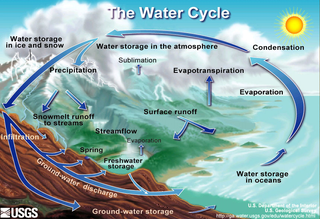@ Sahana : Refer to answer given by Shubham. He has answered well but I would like to add to its definition.
"Water cycle" is the cyclic movement of water between lithosphere, hydrosphere and atmosphere of earth. It is also known as hydrologic cycle.
@ Shubham : Good work, keep posting!
- 2
The water cycle, also known as the hydrologic cycle or the H2O cycle, describes the continuous movement of water on, above and below the surface of the Earth. Although the balance of water on Earth remains fairly constant over time, individual water molecules can come and go, in and out of the atmosphere. The water moves from one reservoir to another, such as from river to ocean, or from the ocean to the atmosphere, by the physical processes of evaporation, condensation, precipitation, infiltration, runoff, and subsurface flow. In so doing, the water goes through different phases: liquid, solid (ice), and gas (vapor).
The water cycle involves the exchange of heat, which leads to temperature changes. For instance, when water evaporates, it takes up energy from its surroundings and cools the environment. When it condenses, it releases energy and warms the environment. These heat exchanges influence climate. By transferring water from one reservoir to another, the water cycle purifies water, replenishes the land with freshwater, and transports minerals to different parts of the globe. It is also involved in reshaping the geological features of the Earth, through such processes as erosion and sedimentation. Finally, the water cycle figures significantly in the mainten ance of life and ecosystems on Earth.
ance of life and ecosystems on Earth.
- 2
t's a big circle: Rising air currents take the water, as vapor, up into the atmosphere, along with water from "evapotranspiration," which is water transpired or "breathed out" from plants and evaporated from the soil. The cooler temperatures in the atmosphere cause it to condense into clouds, which float around until the fall from the sky as precipitation. Some precipitation falls as snow and can accumulate as ice caps and glaciers, where it can stay, as frozen water, for thousands of years. In warmer climates, snow melts during the warmer spring and summer months, and that water flows into streams and rivers, which eventually return it to the ocean, or into the groundwater, which eventually reach underground aquifers. Over time, the water continues flowing, some to reenter the ocean, where the water cycle renews itself. There are four basic steps that tie this all together.

Four steps in the water cycle
- Evaporation occurs when water transforms from liquid to gas, usually as a result of the sun's warming rays. Evaporation often technically includes transpiration from plants (the vapor the "breathe" out as they grow), though together they are specifically referred to as evapotranspiration.
- Condensation occurs as the vapor rises into the atmosphere, creating clouds and fog. Once clouds are formed, advection -- the movement of water in its various states -- through the atmosphere. Without advection, the cycle would screech to a halt, as the water would evaporate and precipitate (the next step) in the same place.
- Precipitation occurs when the vapor that condensed comes back out of the sky as rain, snow, sleet, hail. Most of it comes back to the ground or body of water, but some of it is intercepted by plant foliage and evaporates back to the atmosphere instead of making it to the ground, in a process called "canopy interception."
- Runoff is the process by which water moves across land and includes both surface runoff -- when water travels over land -- and channel runoff -- when it gets into streams and rivers. As is bubbles and rambles along, it can drain into the ground, evaporate into the air, run into and become stored in lakes or reservoirs, or be gathered up for human uses.

- 2

